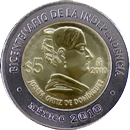Coins issued on 2008
Lawyer, miner, and farmer from Tlalpujahua, who joined Hidalgo's forces early, in Maravatío, and became Hidalgo's secretary. From the beginning of the struggle, he devoted himself to formally constitute an insurgent authority. At the same time, he was the key promoter of El Despertador Americano, the newspaper of the Independence movement.
After the defeat of the insurgents at the Calderón Bridge, López Rayón followed the main caudillos in their journey north, but he split paths with them in Saltillo to complete the task they gave him: to continue the fight. On his return to Michoacán, entrenched himself at Zitácuaro, where he established the Supreme Governing Junta (August 1811), of which he was president, along with José Ma. Liceaga and José Sixto Verduzco (spokesmen). Many laws, proclamations and rules were written by this Junta. After the fall of Zitácuaro to the royalists, the Junta survived as a migrating government until it was incorporated, in 1813, into the proceedings of the Chilpancingo Congress.
Although Ignacio López Rayón contributed actively to Mexico's Independence movement in military affairs (where he was part of key events), without a doubt, his most significant contribution was in the realm of political affairs as he participated importantly in the Chilpancingo Congress and the Apatzingán Constitution, which set the basis for the construction of Mexico's constitutional principles.
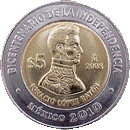
Lawyer, journalist, politician, and historian from Oaxaca, who, upon learning of the events that took place in Mexico City in 1808, sympathized profoundly with the cause of Independence. In light of possible political persecution he could be subject to for exercising his right to print news, Bustamante joined the insurgent forces of Morelos, published the Correo del Sur, and participated in sessions of the Chilpancingo Congress—in particular, in the editing of the act of Independence. For that, Bustamante was persecuted by the royalist forces until he was captured, in 1818, in San Juan de Ulúa. Pardoned the following year, Bustamante took up political activity again, confronted Iturbide, and went back to was imprisoned again until 1823, when he joined Congress. His work as an historian is also an important part of his legacy.
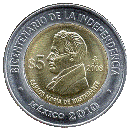
Liberal Spaniard who during his exile in London met with the also exiled priest Servando Teresa de Mier, along with other supporters of the Mexican Independence movement. For Mina, the battle against the absolutist government represented by Fernando VII could be fought in Spain as well as in its colonies. For that reason as well as the search for better battle conditions, Mina moved to the New World. He arrived in North America in 1816 to prepare his expedition to New Spain and, the following year, landed in Soto la Marina. There he started an epic military campaign which led him to travel through territories in the northeast and center of the viceroyalty. He obtained resounding victories such as those of the Hacienda de Peotillos and El Arrastradero. Mina joined his forces with those of the insurgent leader Pedro Moreno in the battles of Sombrero and Los Remedios. After many difficult encounters with the royalist forces in which he demonstrated his military prowess, Mina was finally captured in October 1817 and executed by firing squad soon afterwards.
Apart from the military challenges of General Francisco Xavier Mina and his Mexican Auxiliary Army, his expedition to Mexico broaden the perspective on the War for Independence at a time where it had been reduced to a minimal level with only a few caudillos, such as Vicente Guerrero and Guadalupe Victoria keeping the fight alive. From another point of view, Mina's expedition represented a high point in solidarity from other nations with the cause of Mexican independence.
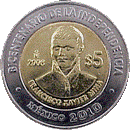
Educated under the influence of Enlightenment ideals, Primo de Verdad was one of the most important promoters and defenders of the social contract and of popular sovereignty in New Spain. Faced with the abdication of the Spanish monarchy due to the Napoleonic invasion of the Iberian peninsula, many Mexicans thought, as any subject of the Spanish Crown would, that they had the right to establish a provisional government that would exercise the authority the king had relinquished. In 1808, the viceroy Iturrigaray called upon the nobles of the viceroyalty to constitute that government. Among those who stood out were Francisco Primo de Verdad (at that time a representative of Mexico City's government), Francisco Azcárate, and Melchor de Talamantes. In response to this first attempt to establish a government fully independent from Spain in Mexico, the Yermo riot broke out, leading to the imprisonment of Primo de Verdad, who died in jail shortly afterward. For this reason, Primo de Verdad is considered one of the first martyrs of Mexico's Independence.
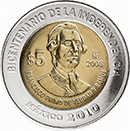
This coin has two varieties: one with dots (established under the corresponding decree) and the other one without them. The dots are on the reverse side of the coin; that is, on the side where the historical figure appears, next to the legend “MEXICO 2010”. The coin without dots was really a defect or error in the minting process. In numismatic terms, by having different features, this type of coins have a different value in the market, which is not determined by Banco de México.
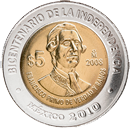 |
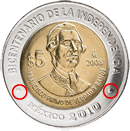 |
Priest that supported the insurgency cause, for which he was imprisoned by the viceregal government at the beginning of the uprising. In 1811, he escaped prison and joined the insurgent forces of Morelos. In a short time, he demonstrated military talents in the battles of Cuautla, Izucar, and Oaxaca, among others. Captured in the attempt to take Valladolid, he was executed by firing squad in February 1814. Along with Galeana, Matamoros was one of Morelos' two most distinguished officers.
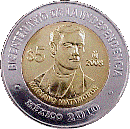
Priest and politician from Coahuila that was nominated congressional representative for that state in the legislative assembly of Cádiz, where he stood out for his independent and liberal principles. In the face of the return of Fernando VII to the Spanish throne, his political convictions led him to four years of imprisonment in Spain. Later, in 1820, he again participated in the Spanish legislative assemblies. In 1822, he returned to Mexico as President of the Commission of the Constitutional Congress of 1823, in which he participated in a notable way as the key editor of the Constitution of 1824 and as a promoter of federalism and autonomous municipalities. Ramos Arizpe was one of the most outstanding liberal politicians and federalists who participated in the defense and construction of independent Mexico.
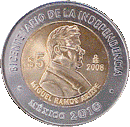
Farmer from the Costa Grande region, who in 1810 joined the rebel forces of General Morelos with a group of men and provided the first cannon to the insurgent army. His outstanding participation in important battles in the south of New Spain led him to become, along with Mariano Matamoros, one of the two most important military collaborators of Morelos. Galeana also enjoyed great prestige among the coastal population, something that allowed him to incorporate significant contingents to Morelos' insurgent forces.
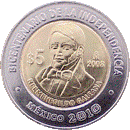
Coins issued on 2009
The contributions of José María Cos to political thought and journalism in Mexico during the War of Independence were crucial. In the political sphere, he brought a solid discourse to the insurgency that was built on liberal theory, particularly in his collaborations with the Zitácuaro Junta. As a journalist, he founded two insurgent daily newspapers: El Ilustrador Nacional and El Ilustrador Americano, to which Andrés Quintana Roo contributed. Cos' political and intellectual talents were recognized by both the insurgent and royalist sides. The royalists even recriminated Viceroy Venegas on many occasions for having driven Cos to collaborate with the independence movement.
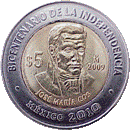
From the start of the War of Independence, Pedro Moreno was friendly with the principal insurgent caudillos, earning him repeated threats of imprisonment, until he formed his own insurgent army with campesinos from the Bajío region. He established his center of operations in the fort of Sombrero, from which he attacked the royalist forces of Bajío and Los Altos. He survived the worst years of the royalist repression and in 1817, joined his forces with those of Francisco Javier Mina. Together they undertook various successful military endeavors in the Bajío, until in October of that year Moreno died in combat in the vicinity of the Hacienda de Venadito. Pedro Moreno was undoubtedly an outstanding fighter for independence, even under the most adverse conditions.
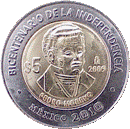
Agustín de Iturbide joined the Valladolid army in his youth, and like many other Creoles of the time, he sympathized with the ideas of the independence movement, particularly with the Michelena conspiracy in Valladolid. However, he remained true to the royalist cause despite having received offers from Miguel Hidalgo to join the insurgent struggle. As a royalist officer, he participated in various armed acts; in particular, he fought General Morelos. In the final stages of the viceroyalty, once the Liberal Constitution was re-established in Spain, he joined the Profesa conspiracy, which sought to impede the application of the Spanish Constitution to New Spain and thereby, to preserve absolutism. In 1820, Iturbide was charged with fighting General Guerrero in the south. Since Iturbide could not defeat him, the two men had a series of meetings in view of the fact that, at that time, insurgents and absolutists alike agreed on the need to make Mexico independent. After a first meeting between the two in Acatempan, both leaders enacted the Plan of Iguala, establishing, among other things, the independence of New Spain and the founding of a non-absolutist monarchy (a constitutional monarchy). On September 27, 1821, Mexico's independence was sealed with the entrance of the Army of Three Guarantees (Religion, Independence, and Union), led by Agustín de Iturbide.
Iturbide's imperial experiment (from May 1822 to March 1823) was marked by failure. The Plan of the Casa Mata led to a revolt that put an end to his regime, opening the way to the establishment of a republican regime in Mexico. Iturbide went into exile in Europe for some time but egged on by sympathizers, returned to Mexico where he was arrested, tried, and executed by firing squad in 1824.
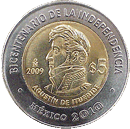
A Dominican friar who in December 1794 gave a famous speech on the Virgin of Guadalupe, leading to his expulsion from Spain. From that time on, he lived a life of arrests and escapes in Europe until finally, in 1811, he moved to London to support the cause of Mexican Independence in the press. There he met Mina and joined Mina's expedition; however, he was captured in Soto la Marina, put on trial by the Inquisition, made prisoner and sent to Spain. Mier re-escaped to Havana, Cuba, from which he went to the United States and later to Mexico, where he was captured again for his stand against Iturbide's First Empire. In 1823, Mier escaped for the seventh and final time and joined the Constitutional Congress, in which he was notable as a critic of federalism. His contribution to Mexico's independence stands on several levels: the spreading of the movement through the press, ideologically, and even in military matters. Just as important as his participation in the fight for freedom was his contribution to the founding of the Mexican Republic.
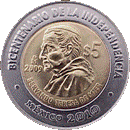
At the beginning of the Mexican War of Independence, Nicolás Bravo, along with the rest of his family, sympathized with the insurgency and joined the forces of Morelos under the command of Hermenegildo Galeana. He quickly gained notice for his military talents and bravery, leading him to be named Military Commander of the Province of Veracruz. A story about how he freed prisoners when he learned of the royalist capture and execution of his father is famous.
Captured in 1817, Bravo remained in prison until 1820, when the Plan of Iguala was agreed upon. Taking the side of the republicans, he joined Guerrero to fight the empire of Agustín de Iturbide. His political activity led him to form part of the Triumvirate that preceded the birth of the Mexican Republic. Once the republican order was established, Bravo participated frequently in national politics, defending centrist principles.
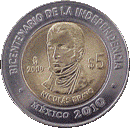
When the War of Independence broke out, Leona Vicario collaborated in various ways with the insurgency: she kept the movement informed of events in Mexico City, contributed financially to the cause, and tried to take better fighting equipment to the rebel camp, which earned her a prison sentence. She escaped and went to Oaxaca, where she joined Morelos's forces. There she contributed to the efforts of the insurgent press. Because her possessions were confiscated during the war, in 1822 she was given the Hacienda de Ocotepec.
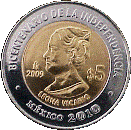
Coins issued on 2010
Priest whose liberal ideas led him to participate in the Dolores conspiracy in favor of Mexican independence. When the group's desires for independence were discovered, Hidalgo decided to set the ball rolling toward independence by calling up the faithful who attended the parish church of Dolores in the early morning hours of September 16, 1810, in order to initiate the movement. In very little time, the insurgent movement headed by the priest of Dolores advanced rapidly through the territory of New Spain: from Dolores the movement went to San Miguel el Grande, Atotonilco, Chamucuero, and Celaya (where Hidalgo was conceded the rank of captain and became head of the movement). The insurgent forces continued on their path through Salamanca, Irapuato, and Silao, until they arrived at Guanajuato, where they took the main plaza after a fierce battle. Later, Hidalgo, leading the patriots, advanced to Valladolid and Mexico City, in the outskirts of which he achieved a significant victory (Monte de las Cruces). However, due to disagreements with other insurgent caudillos, he decided not to occupy the viceregal capital and went instead to Guadalajara. On the Calderón Bridge, close to that city, the insurgent movement was defeated and forced to redeploy toward the north. In May 1811, on the plains of Acatita de Baján, Hidalgo and his closest comrades in arms, victims of a betrayal, were captured and most of them later executed. Hidalgo was executed by firing squad on July 30, 1811.
By that time, the insurgent revolt initiated and directed by Miguel Hidalgo had turned the viceregal regime on its head and could be repressed only with great difficulty. Hidalgo, later recognized as the Father of the Country, was not only the initiator and main leader of the insurgency in its first stage, but also gave the independence movement a deep social significance, since it called the working and popular classes to act and created important measures in their favor, such as those decreed in December 1810 in Guadalajara, which abolished slavery.
Miguel Hidalgo was important in Mexico's War of Independence not only because of his role as founder of the movement and main caudillo in the first stage of the fight, but more than anything else because of the social dimension he gave to the revolt when he turned to the people as the principal agent of change and granted meaning, form, and a response to their hopes and demands.
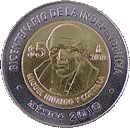
A student of Miguel Hidalgo in the Colegio de San Nicolás, Morelos took charge of the Curácuaro and Nicupétaro curates. When Hidalgo's armies set off towards Valladolid, Morelos met with him and offered his services. In exchange, he received the rank of colonel and the order to extend the insurgent movement to the south of the viceroyalty. In a short time, Morelos stood out for his military talents, which allowed him to occupy the southern coast, Chilpancingo, Tixtla, Izucar, and Cuautla (where he escaped heroically from the siege to which it was subjected), Oaxaca (where he established the Correo Americano del Sur), and Acapulco, the royal bastion of the south. However, the restructuring of the royalist forces prevented him from taking Valladolid and brought about his defeat and capture in Tezmalaca in November 1815. Morelos was executed by firing squad in San Cristóbal Ecatepec in December 1815. Although Morelos did not achieve the defeat of the viceregal regime, the regime never managed to fully restore itself after him.
As noteworthy as his military success was his political work. He was the first insurgent caudillo to break the bond with Fernando VII and fight for Mexico's absolute independence. In addition, he actively promoted a republican political structure and the founding of the Congress of Chilpancingo (1813), the drafting of the Constitution of Apatzingán (1814), the first which established, among other things, a republic, equal rights among Spaniards, Creoles, Indians, mestizos, and members of the castes, the right to vote for all men, limits on land ownership, and free and obligatory education. Morelos was an indefatigable defender of the interests of the oppressed and intervened in practically all levels of life in the territories under his command. His ideals were published in the “Veintitrés Puntos Constitucionales” (the 23 Constitutional Reference Points), better known as the “Sentimientos de la Nación” (the Feelings of the Nation).
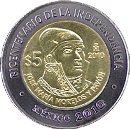
A man of humble origins in the town of Tixtla, Guerrero joined the forces of the Galeana brothers under General Morelos in November 1810. During the War of Independence, he distinguished himself in various military feats such as the Battle of Izucar and the siege of Oaxaca. Because of his talent, Morelos gave him the task of leading the rebellion in the south of the state of Puebla. Due to the manufacture of gunpowder, the smelting of artillery and, above all, to the growth of troop numbers, Guerrero won resounding victories in the region. He was in charge of protecting the Congress of Chilpancingo and establishing a guerilla force that kept the fight for independence alive in the south during the most difficult years of the insurgency. Finally, despite rudimentary training and thanks to his special political sensitivity, Guerrero foresaw the possibility of uniting the belligerent forces in the face of the liberal triumph in Spain and promoted the alliance with Iturbide to obtain Mexican Independence in the Plan of Iguala. The plan recognized independence, the establishment of a constitutional monarchy, equal rights for all Mexicans, and Catholicism as Mexico's sole religion.
When the Empire fell, Guerrero was a substitute member of the Triumvirate that succeeded the fallen regime, as well as a member of the New York lodge and the progressive party, and a defender of federalism. In 1829, Guerrero occupied the presidency of the Republic without much success, and two years later he was betrayed and assassinated.
Guerrero was without doubt one of the caudillos most committed to the fight for Independence and to the Mexican people, even in the darkest moments for the patriots. Indubitably, he was one of the most prominent representatives of the radical wing of the insurgency. Despite minimal training, his military talent, political instincts, and commitment to the nation were obvious. His repeated participation in the construction of Mexico's republican regime is also undeniable.
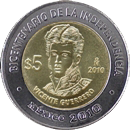
Creole soldier who from the beginning of the nineteenth century sympathized with Mexican aspirations for independence, leading him to participate in the Valladolid and Dolores conspiracies. Together with Hidalgo, he was one of the key caudillos and initiators of the independence movement. As General Captain of the insurgents, Allende distinguished himself in the military events that took place in the center region of New Spain between September 1810 and March 1811. At the same time, he tried at various times (though unsuccessfully) to impose order on the insurgent troops.
The military defeats of the initiators of the War of Independence generated differences among Hidalgo, Allende, and other leaders. Nevertheless, none of them diminish the role of the insurgent caudillos. At the moment of his capture in Acatita de Baján, Allende resisted but once imprisoned, confronted his trial with dignity and without compromising anyone else in his statements. He was sentenced to die, and in June 1811, he was executed.
Allende represents as few do the patriotism and commitment of the first caudillos to the cause of independence.
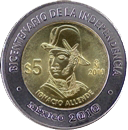
Miguel Fernández Félix, the real name of Guadalupe Victoria, joined Morelos’s insurgent forces, where he distinguished himself as a soldier, particularly during the assault on the city of Oaxaca. Later, when the insurgency had been reduced to a minimum, Victoria controlled the road to Veracruz and made the Puente del Rey his center of operations. Transit on that road, the most important route in the viceroyalty, was constantly threatened by Victoria’s guerrillas, who were pursued aggressively by the royalist soldiers. Despite his isolation and apparent defeat, Victoria rejected continuously royalist offers of amnesty, and it was not until the signing of the Plan of Iguala that he reappeared publicly on the Mexican political stage.
After independence was achieved, Victoria joined Antonio López de Santa Anna in the fight against Iturbide’s empire and finally, after a distinguished career, he was elected President of Mexico (1824 a 1829). His presidential term saw the beginning of international recognition of the young republic, the surrender of the fort of San Juan de Ulúa (the last Spanish redoubt in Mexico), and the abolition of slavery. Summing up, Guadalupe Victoria was one of the few caudillos who contributed to the Mexican War of Independence and, later, to the construction of a new country according to republican, liberal, and federalist principles—i.e., the most progressive ideas of the time.
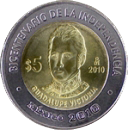
Wife of the Corregidor (magistrate) of Querétaro, Miguel Domínguez. She played a fundamental role in the start of the War of Independence. Before September 1810, she associated herself with the insurgency through one of her daughters, who was engaged to Allende. Doña Josefa led her husband toward the movement and kept the leaders informed of what they needed to know in the fight for freedom. When she found out that the Dolores conspiracy had been discovered by the viceregal authorities and that the Corregidor was about to initiate the corresponding investigation, Doña Josefa got one step ahead of events and apprised independence leaders, producing the spark that ignited the War of Independence in September 1810. Captured due to her collaboration in the insurgency, the Corregidora, as she was known, was imprisoned for several years in various convents. When Mexico won its independence, she accepted no recompense for her services and was critical of the regimes of independent Mexico.
